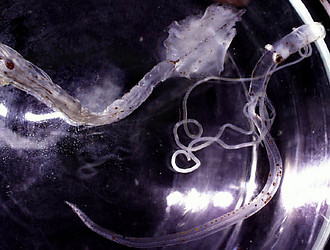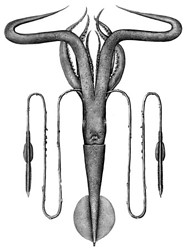Chiroteuthis spoeli
Clyde F. E. Roper and Richard E. YoungThe illustrated squid is deposited in the National Museum of Natural History, Smithsonian Institution, Washington, D.C., U.S.A..
The holotype is deposited in the Zoological Museum of Amsterdam, University of Amsterdam, Netherlands.
Introduction
Chiroteuthis spoeli is a broadly distributed species that is similar to Chiroteuthis joubini and Chiroteuthis sp. B2 in the three-part division of the club protective membranes. It is closest to C. sp. B2 but is most easily separated by the arm sucker size and dentition.
Diagnosis
A Chiroteuthis ...
- with club protective membranes divided into three divisions of roughly the same size.
- with large arm suckers globular in form and bearing broad, truncate teeth.
Characteristics
- Arms
- Largest suckers with 12-15 broad, rounded to truncate teeth, fused laterally in distal 1/2 - 2/3 of ring; proximal portion smooth; more distal suckers with thin blunt teeth; more proximal suckers with broader, rounded teeth.
- Largest suckers globular.
- Tentacular clubs
- Suckers with 7-8 long, triangular, sharply-pointed teeth over distal half of ring; no enlarged central tooth.
- Sucker stalks in two distinct parts (long, cyclindrical base and short, constricted portion that attaches to sucker); stalks of lateral and medial suckers about equal in length.
- Protective membranes in three distinctive sets with intermediate set broadest and consisting of fused trabeculae.
- Head
- Beaks: Descriptions can be found here: Lower beak; upper beak.
- Beaks: Descriptions can be found here: Lower beak; upper beak.
- Photophores
- Eyeball: Two series: lateral series with 7-8 round photophores; medial series with 6-7 round photophores.
- Viscera: two, large organs.
 Click on an image to view larger version & data in a new window
Click on an image to view larger version & data in a new window
Figure. C. spoeli, nearly mature male, size ?. Ventral view of the visceral photophores of a fresh (unfixed) squid; anterior is at the top of the image. Compare this appearance with that of the visceral photophores of C. calyx and C. veranyi. Photograph by R. Young.
- Eyeball: Two series: lateral series with 7-8 round photophores; medial series with 6-7 round photophores.
Comments
Chiroteuthis spoeli exhibits considerable variation in the size of the globular suckers and the degree of restriction of the sucker aperature. Also considerable variation exists in the number of trabeculae in the proximal portion of the club. Because of this large variation, the possibility exists that C. spoeli is a species complex. There seems to be intergrades between Chiroteuthis spoeli and Chiroteuthis B2 (e.g. see SEMs of arm suckers for Chiroteuthis B2) and these forms may not represent separate species. We have not examined many Chiroteuthis joubini and intergrades between this and form B2 may exist. Therefore the C. joubini complex may consist of a variety of species or one highly variable species that includes C. joubini, Chiroteuthis B2 and C. spoeli. We have examined variation in sucker dentition but not variation in other features and, therefore, cannot resolve the taxonomy at present.
More details of the description can be found here.
Because of the uncertainties of the species boundaries of C. spoeli, a description of the holotype of this species can be found here.
Life history
The doratopsis paralarvae of C. spoeli are known from Hawaiian waters. In the doratopsis paralarvae of C. spoeli, the esophagus lies in a dorsal position within the brachial pillar. In other species, the esophagus is more commonly located in a central location within the brachial pillar (Young 1991). Maximum size of paralarvae is about 90 mm ML. The smallest subadult known is 65 mm ML indicating considerable variation in the size at "metamorphosis."


Figure. This is a photograph of a large (90 mm ML) Chiroteuthis spoeli doratopsid paralarva captured in the central North Pacific (27°N, 165°W) on a squid jig in surface waters at night. During capture and handling one tentacle and one of the ventral arms were broken off, the head separated from the mantle and the tail was lost. Note the extreme slenderness of the paralarva, the very long ventral arm and long tentacle (wrapped around the head), the small reddish-brown digestive gland near the anterior end of the mantle, and the dorsal position of the oesophagus. Photograph by R. Young.


Figure. Paralarvae of C. spoeli, Hawaiian waters. A - Side view of head, 2.4 mm ML; shows the dorsal position of the esophagus within the brachial pillar and large number of chambers in the brachial pillar. B - Dorsal and ventral views, 5.3 mm ML. Scale bar is 1 mm. C - Dorsal and ventral views, 9.6 mm ML. Drawings from Young (1991).
Distribution
Vertical distribution
The vertical distribution of subadults of Chiroteuthis spoeli is known from a few squid captured off Hawaii. The three captures made during the day suggest a habitat between depths of 700 and 800 m. At night captures were scattered from the surface to 750 m with most from the upper 200 m.
Figure. Depth chart of the vertical distribution of C. spoeli, Hawaiian waters. Captures were made with both open and opening/closing trawls. Bars- fishing depth-range of opening/closing trawl. Circle- Modal fishing depth for either trawl. Blue-filled circles- Night captures. Yellow-filled circles- Day capture. Chart modified from Young (1978).
Geographical distribution
The species is known from the tropical and temperate Atlantic and tropical Pacific and Indian Oceans.References
Salcedo-Vargas, M. A. 1996. Cephalopods from the Netherlands Indian Ocean Programme (NIOP) - I. Chiroteuthis spoeli, n. spec. and Chiroteuthis picteti somaliensis n. subspec. Beaufortia, 46: 11-26.
Young, R. E. 1978. Vertical distribution and photosensitive vesicles of pelagic cephalopods from Hawaiian waters. Fish. Bull., 76: 583-615.
Young, R. E. 1991. Chiroteuthid and related paralarvae from Hawaiian waters. Bull. Mar. Sci., 49: 162-185.
Title Illustrations

| Scientific Name | Chiroteuthis sp. B2 |
|---|---|
| Location | Hawaii |
| View | ventral |
| Image Use |
 This media file is licensed under the Creative Commons Attribution-NonCommercial License - Version 3.0. This media file is licensed under the Creative Commons Attribution-NonCommercial License - Version 3.0.
|
| Copyright |
© 1996

|
About This Page
We acknowledge

Smithsonian Institution, Washington, D. C., USA

University of Hawaii, Honolulu, HI, USA
Page copyright © 2019 and
All Rights Reserved.
- Content changed 10 October 2017
Citing this page:
Roper, Clyde F. E. and Richard E. Young. 2017. Chiroteuthis spoeli . Version 10 October 2017 (under construction). http://tolweb.org/Chiroteuthis_spoeli/19478/2017.10.10 in The Tree of Life Web Project, http://tolweb.org/









 Go to quick links
Go to quick search
Go to navigation for this section of the ToL site
Go to detailed links for the ToL site
Go to quick links
Go to quick search
Go to navigation for this section of the ToL site
Go to detailed links for the ToL site